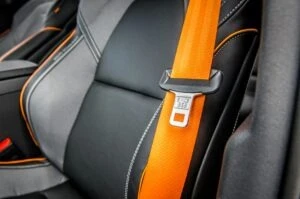
Buckling up is one of the easiest and most efficient safety precautions you can take before operating a vehicle. It’s fortunate, then, that wearing a seat belt is mandated by almost every state in the U.S., including Ohio.
But believe it or not, this wasn’t always the case. It wasn’t until the latter half of the 20th century that car manufacturers were required to outfit every car with seatbelts, which means that some older cars may come without them.
If you’re a vintage car lover who might be concerned about whether your older car complies with the state’s seat belt laws, you should know that a car is exempt from the seatbelt law if the car was manufactured prior to the year 1966. But you should exercise caution: choosing not to retrofit vintage cars with modern safety devices like seat belts can come at potentially dangerous costs.
Seat belts are life-saving tools that can act as the deciding factor between injury and fatality in an accident. However, even if you weren’t wearing one at the time of an accident, you may still be able to pursue monetary compensation. If you have questions and would like to speak to an experienced Columbus car accident lawyer, you can call The Fitch Law Firm at (614) 412-8477.
Seat Belt Use: A Brief Historical Perspective
For most Americans, wearing a seat belt is now a common habit. According to the National Highway Traffic Safety Administration, the national seat belt use rate was more than 90% in 2024, but these sorts of numbers are a relatively more recent development in the history of the automobile.
For more than half of the 20th century, seat belts weren’t commonly worn, and they were rarely, if ever, worn for the first few decades of the century. At the time, there were widespread myths that in the case of an accident, it would be safer to be flung from the car than remain inside the motor vehicle as it collided and potentially burned. Manufacturers, too, held misleading beliefs, afraid that including too many safety features would give their consumers the impression that cars were unsafe (AAA).
With seat belts being unpopular for so long, car manufacturers weren’t required to include them until the late 1960s, when a new federal law instructed all new cars to be manufactured with them. Since some older cars were made prior to seat belt laws, they are exempt from current seat belt laws. In Ohio specifically, you can operate an older car without a seat belt so long as the car was built before 1966 (ORC).
Seat belt use grew more popular as the decades wore on, but as recently as the 1970s and 1980s, seatbelt use was only between 11% and 14% (AAA). It was in the years between 1984 to 1987 that the U.S. saw the most growth in seat belt use, as this period was when 29 states adopted mandatory seat belt laws.
Does Not Wearing a Seat Belt Affect My Claim?
Yes, not wearing a seat belt can affect your claim if you get into an accident, but it doesn’t completely prevent you from receiving compensation.
If you are the victim of negligent driving, you may be entitled to a variety of damages, including:
- Medical expenses (past, present, and future)
- Lost wages and diminished earning capacity
- Property damage
- Pain and suffering
- Emotional distress
- Loss of enjoyment of life
Ohio operates under what is known as a comparative negligence system, which means that any injured party’s degree of fault in an accident proportionately affects the damages they can recover (ORC). If you were involved in an accident, insurers or at-fault drivers can point to the fact that you weren’t wearing a seat belt to claim that your own negligence amplified and contributed to your injuries, and your potential compensation would therefore be negatively affected.
For instance, if you initially sought $1,000 for non-economic damages, but the judge or jury finds that you’re not wearing a seat belt, which compounded your suffering by 25%, you may only receive $750. However, it’s important to note that if you were found to be more than 50% at fault for the accident, you won’t be able to recover damages from the collision at all.
At The Fitch Law Firm, we understand that the legal process can seem complex and difficult to navigate, and we believe that victims of road accidents should be able to focus on recovery and still receive the compensation they deserve. Work with a dedicated Ohio personal injury lawyer to determine the details of your case and your potential compensation.
The Possible Consequences for Not Wearing a Seatbelt
In Ohio, seat belt laws fall under secondary enforcement. This means that you can’t be pulled over for the sole violation of not wearing a seatbelt, but an officer can pull you over for a different offense, such as speeding, and issue you a citation for the seatbelt as well.
If you are found to be in violation of Ohio’s seat belt laws, you may be fined.
We strongly encourage you to always buckle up and familiarize yourself with Ohio’s basic seat belt laws:
- Anyone 16 or older must wear a seat belt when riding in the front passenger or driver’s seat.
- Children ages 8 to 15 must always wear a seat belt, regardless of whether they are in the front or back passenger seats.
- Children younger than 8 must use a booster or child safety seat while in the car.
Wearing a Seat Belt Greatly Improves Your Safety
Older cars that are exempt from seat belt laws aren’t legally obligated to retrofit their car with seat belts, but it is always strongly encouraged to prioritize safety and buckle up. When you drive or ride without using the available safety restraining devices, you run the risk of suffering serious harm. In 2023, nearly 24,000 people died in car accidents, and nearly 50% of those killed weren’t wearing a seat belt (NHTSA).
Wearing a seat belt significantly diminishes the risk of fatalities and injuries in the case of an accident. According to the National Highway Traffic Safety Administration, it can lower the risk of fatal injury by 45% and the risk of critical injury by 50%.
We Will Be
There To Help
You All The Way
If You Were in a Car Accident, Get a Free Consultation
If you or someone you know was the victim of a driving accident, reach out to a knowledgeable Columbus car accident attorney who can help you understand your legal rights, investigate the circumstances surrounding the accident, and gather crucial evidence such as witness testimonies, surveillance footage, or expert analysis.
Reach out to The Fitch Law Firm today for a free consultation. We can discuss the circumstances of your accident and guide you through your legal options. At The Fitch Law Firm, we specialize in helping victims of car accidents navigate the complexities of Ohio law and obtain the compensation they deserve.
